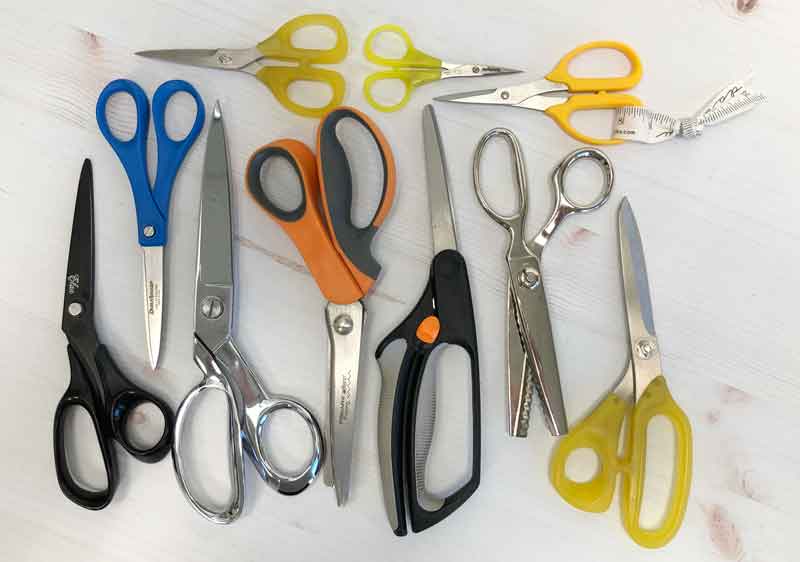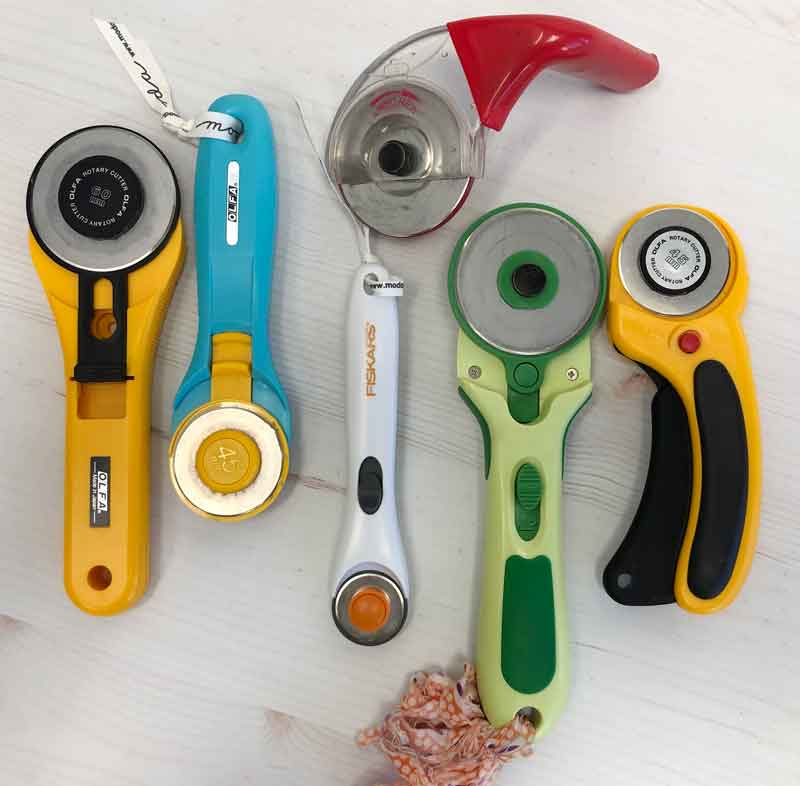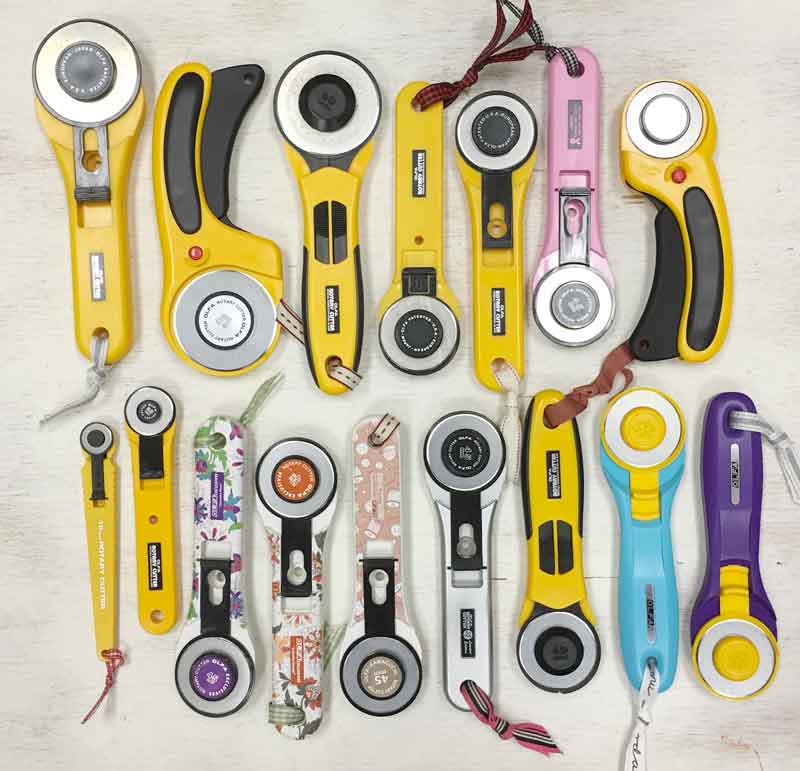Welcome to Moda Fabrics!
I've Got A Notion - Cutting
I've Got A Notion - Cutting
Whether you're making a quilt, a pillow or bag, or something to wear, at some point you're going to have to cut fabric. So today, it's all about scissors and rotary cutters.

This isn't a "best of" kind of list so much as a guidebook/glossary. What are "duckbill scissors" and do I need them? How do I know which rotary cutter is best for me?
You already know that there are dozens of manufacturers for every kind of tool and dozens of options from each of them. Your favorite quilt shop can't possibly carry all of them and that's okay because honestly, most of us don't need most of these things. But we should know what they are because depending on the kind of stitching you do, you just might want a Skip Rotary Cutting Blade.
We also have a "cheat sheet" download for Cutting Tools 101 - but more about that in a few.
So let's get started.
Scissors. They're described as a hand-operated tool used for cutting and shearing. They consist of a pair of metal blades pivoted so that the sharpened edges slide against each other when the handles are opened and closed.
The earliest known scissors date back almost 4,000 years to Mesopotamia and were a spring scissor - rather like snips. Pivoted scissors - the kind we use today - began appearing in 1761 and were manufactured by William Whiteley & Sons Sheffield.
Scissors or shears? Scissors have symmetrical, equally sized finger holes and are generally under 6" in blade length, while shears have different size finger holes and are generally have blades more than 6" in length. Note that all shears are scissors but not all scissors are shears.
Dressmaker's Shears. This type of shear generally has a long blade - 7" to 10" long - and are designed for cutting fabrics. The blades are tapered, with one sharp point and one rounded tip that prevents the fabric from snagging on threads or the fabric. The blades have a sharp "knife edge" with the top blade having a sharper angle to allow them to cut the fabric cleanly - to "shear" the fabric.
Multi-purpose scissors. The most common scissors used for sewing and quilting. They often look much like shears with different size finger holes and blades, though they generally have a shorter blade length. Like shears, these scissors will cut fabrics.
Pinking Shears. These are shears with zig-zag or scalloped edged blades that cut a neat edge along the edge of the fabric. They are used for practical and decorative purposes - they can eliminate frayed edges or put a pretty edge on a patch.
Paper-cutting scissors or small craft scissors. These are small scissors with symmetrical or different-size finger holes, blade lengths shorter than 4", sometimes with blunt or rounded tips. They are designed for cutting paper though some are sharp enough for cutting threads.
Thread Snips - "Snips". These are small spring-scissors with sharp-pointed blades designed to snip stray threads. They can also be used for clipping curves, seams and notches.
Embroidery scissors. These are small scissors generally less than 5" in length with blades less than 3" in length. The finger holes are identical. The pointed blades have a sharp edge to enable precision trimming, and the sharp point will cut to the tip.
Curved embroidery scissors. These embroidery scissors usually have a shorter blade length, and the blades have a slight curve at the tip to make cutting threads easy - particularly on raised embroidery work.
Appliqué scissors. These are also called "duckbill scissors". Appliqué scissors are usually 6" or less in overall length, with a blade length of 2" or less. The bottom blade has a paddle shape that does two things - first, it protects the base fabric from being cut during trimming of the upper fabric. The blades also lift the top fabric during trimming, allowing for close, precise trimming.
Buttonhole scissors. These are short-blade scissors designed to cut through the layers of fabric in a stitched buttonhole. They are generally heavy duty as they are primarily used by tailors to cut the buttonholes in wool garments. Some buttonhole scissors have a screw that enables adjusting the length of the cut.
Serrated blades. Scissors with a serrated blade allow for gripping slippery fabrics, or for precise, in-close trimming. Serrated blades tend to stay sharper longer than straight-edged blades.
Seam ripper. Yes, a seam ripper. Most good seam rippers have a sharp blade on the inside curve that can be used for cutting threads, buttonholes and making slits in fabric.
Sharpening scissors. Leave it to the professionals. If you have invested in a pair of high-quality scissors or shears, ask the manufacturer for their recommendations on sharpening, including how often, and if they have any resources. Call a knife-shop and ask if they sharpen scissors, or ask your hair stylist who sharpens their scissors. (Cutting hair requires very sharp scissors.) If you've spent over $50.00 for your scissors, please don't take them to the Saturday scissor sharpener at the big-box store.
While there are DIY videos on how to sharpen your scissors with aluminum foil, steel wool, emery and sharpening stones, don't do it. Because if you take care of good scissors and shears, they really will last a lifetime. A couple of lifetimes.
Rotary cutters. (Aka... the "lifeblood" of quilters.)

While rotary cutters were first introduced for garment making, they were quickly and enthusiastically embraced by quilters. (The first rotary cutter was made by Olfa in 1979 - this year they are celebrating their 40th Anniversary.)
Every rotary cutter consists of a handle with a circular blade that rotates. Multiple layers of fabric can be cut simultaneously and precisely, making rotary cutters ideally-suited for patchwork. (Especially strips!)
Many quilters have several rotary cutters, often with different size blades. We prefer one for trimming HTSs and another for "power cutting" 400 strips for a king-sized log cabin quilt.
Blade size. The most common sizes are 28mm, 45mm and 60mm.
- 28mm blades are preferred for curves, trimming small pieces and fussy cutting.
- 60mm blades roll the most easily and are well-suited for cutting multiple layers of fabric - four or more - and thick fabrics like Snuggle or batting.
- 45mm blades were the first size introduced and they remain the most commonly used. They are well-suited for every aspect of quilting.
- 18mm blades are particularly good for cutting appliqué pieces, curved pieces, notching and clipping curved edges
Handle style. The best handle style is the one that is the most comfortable in your hand, and the one that best-suits how you cut. There are straight-or stick handles, curved handles, ergonomically designed cutters, left-handed cutters and the list goes on.
Specialty blades. In addition to the straight cutting blades, there are blades that edges for specific purposes.
- Pinked - Scalloped - Wave Blades. Using one of these blades in a rotary cutter to cut this alternative edge is an inexpensive alternative to purchasing shears. Note that these blades do not fit all rotary cutter styles. (Try using a pinked or scalloped blade the next time you're trimming lengths of fabric for a backing. With a pinked/scallop blade, there is no fraying when the selvage is removed, or the ends are cut.)
- Blanket Stitch Blade. This blade cuts a straight line of perfectly spaced perforations on fleece, felt, and other non-woven fabrics quickly and easily. This eliminates the need for marking or pre-punching the holes used for a hand-stitched blanket-stitch edging.
- Skip Cutter Blade. The skip blade is made for cutting leather, vinyl, felt, fleece, soft foam and paper. The cuts are closer together and smaller than they are on the Blanket Stitch Blade.
Chenille Rotary Cutter. This cutter has a point that slips under several layers of fabric in the channel between two lines of stitching, cutting the top layers of fabric as it is moved down the row.
Rotary Circle Cutter. This is like a compass with an 18mm blade attached to one end, enabling the cutting of circles ranging from 2" to 8.5" in diameter.
Rotary Cutter Safety. Many rotary cutters have a safety latch that locks a blade-guard in place to prevent accidents. ALL rotary cutters can be closed while not in use - get in the habit of closing the blade every single time you put it down. Every. single. time.
If you have any mobility issues with your hands, test different cutters to find the one that is easiest for you to use and you will be using the latches for closing or safety regularly.
Replacing blades. Most of us don't do this often enough, waiting until we're applying a lot of pressure to the cutter and sawing back-and-forth to cut two layers of fabric.
When you replace the blade, remember to clean the rotary cutter to remove any and all lint. Use a container to collect old-used rotary blades for disposal.
Sharpening blades. Rotary cutter sharpeners are round, hand-held tools with two parts. While some sizes can accommodate any size blade, not all do. While most blades do not have the longevity of good scissors, rotary blade sharpeners can prolong the life of good rotary blade.
Endurance rotary blades. Made from high-quality tungsten carbide, "endurance" blades undergo an advanced production process that results in excellent sharpness and longer blade life. They're more expensive than "regular" blades.
Off-brand rotary blades. Rotary cutting blades can be pricey. There are "off-brands" available through mega-retailers in bulk packages of 10 or more blades for $1.00 per blade. While some companies will claim that their blades are made by the same manufacturers as brand-name blades, that may not be true. What is true is that the quality is inconsistent, and a poor quality blade will not yield good cutting results.
Caring for scissors and rotary cutting tools:
- Cutting paper. Don't use your "good" fabric scissors to cut paper. Ever. Paper generally contains minerals that are abrasive, thereby dulling the blades of the scissors. (Don't use your best scissors for cutting hair either as that can dull the blades too.)
- Cutting wool. The thickness and density of wool fabrics - felted and not-felted - requires very sharp blades to cut cleanly and easily. So cutting wool doesn't dull scissors so much as it needs good scissors with sharp blades.Always keep the tools clean. Wipe the entire tool and individual blades with a clean dry cloth regularly, especially if there is lint on them.
- Keep scissors in a sheath and rotary cutters close when they are not in use. The tools are sharp and will last longer if the edges are protected.
- Oil them to prevent rust and keep them moving easily. Sewing machine oil is lightweight and works well for this. A single drop on the screws of shears/scissors, or a drop underneath the blade of a rotary cutter will do. Thoroughly wipe off any excess with a dry cloth.
- Have scissors-shears professionally sharpened as needed. It bears repeating.
Die- and Shape Cutting Machines. These are machines that use a rolling press to die-cut shapes. E.g., the Accu-Quilt, Go Cutter, Sizzix
Electric Cutting Tools. From electric scissors to commercial laser cutters. Moda has one in the Sample Room and it's great for cutting yardage.
Whew. You don't need to remember all of that, we've got the most important cutting tools here.

Cutting Tools 101 - Look Sharp!
So how many rotary cutters do you have? And pairs of scissors? I will admit to having "more than I need".


Comments